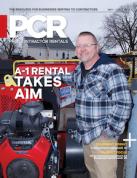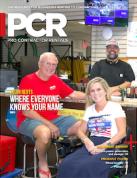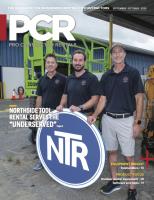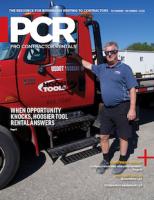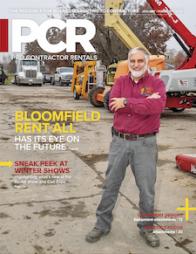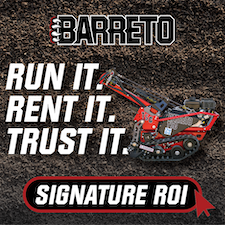Service Tips -- Compact track loader maintenance
Following the principles of good compact track loader maintenance can maximize ROI.
by Mike Fitzgerald
The growth of the compact track loader (CTL) business over the past 20 years continues to be very steady, making this machine a popular choice for rental houses. More renters are choosing a CTL for its ability to complete a variety of complex projects in a wide range of challenging conditions, along with a lower cost of ownership compared to a larger loader.
Throughout the industry, compact track loader manufacturers have also continued to reengineer their designs with advances to operator comfort features and controls technologies that have also contributed significantly to their popularity.
As ownership numbers increase, it’s important to understand how to maintain and protect these investments for an extended lifecycle. Here are 11 tips to help you perform maintenance and get the most productivity and efficiency from your rental fleet.
- Use the manufacturer’s operation and maintenance manuals
The key to optimum performance starts with following the official recommendations of the machine’s manufacturer. An operation and maintenance manual is a must-read in the first few days of ownership for proper understanding of maintenance points, service intervals, instrumentation and safety features. Always keep it stored in your cab for quick reference. - Safety
More manufacturers are designing machines with standard equipment like lift-arm stops. These mechanisms allow for maintenance to be performed while the lift arms are in a raised position. Some models have also been designed with tip-up cabs for easier access to engine and hydraulic system components located underneath the cab area. Operators should always follow manufacturer instructions when performing maintenance procedures. - Instrumentation
Some compact track loaders are designed with on-board instrumentation systems that log, monitor and display vital machine temperatures and pressures. Advanced systems also allow users to store service interval data which will trigger visual and audible warnings to match maintenance schedules. - Fluids and lubricants
As manufacturers introduce machines with new engines that meet federal emissions standards, it’s critical to develop a routine maintenance plan that meets more stringent recommendations for fluids including engine oil, coolant, hydraulic fluid, grease, and drive motor lubricants. Some extreme working environments may require specially formulated lubricants for high and low temperature job sites.
For example, synthetic or synthetic blended oils are formulated with additives that can extend oil change intervals and promote longer engine life. These oils have better cold weather starting and lubricating performance, as well as additional wear protection during severe high-speed, high-temperature operation. For instance, a 5W-40 weight synthetic oil is usually capable of providing protection in harsh conditions as cold as -40F and as hot as 120 F. - Filters
To protect today’s advanced emissions-compliant engine components like high-pressure common rail systems and electronic injectors, filters play an even more critical role than in the past. Following published interval schedules for engine, air, fuel and hydraulic systems filter changes can help reduce potential system contamination and extend the life of core components. - Fuel
A No. 2 or No. 1 “ultra-low sulfur” diesel fuel is required to meet emissions regulations. With newer machines having higher performing and more technologically advanced fuel systems, the need for clean fuels is more important than ever as well. Manufacturers are filtering fuel to finer micron levels to reduce potential damage to these components. - Tracks
Tracks can be an expensive wear component on a CTL but taking precautions on the job site can lengthen the lifespan of your tracks. If your jobsites tend to have hard paved surfaces, you’ll see more abrasion and wear, whereas operating your CTL on softer surfaces such as dirt or sand will give you a longer track lifespan. Evaluate your job site to determine if a CTL is your best option. If you’re on a property with a lot of rocks, roots or rebar, consider a skid-steer loader or wheeled machine, which might be a better option. If you need to use a CTL on a hard-surfaced job site, consider sprinkling material like sand or dirt on the surface to help tracks slide instead of skid. - Undercarriage
One of the hardest working parts of CTL is its undercarriage, so it’s vital to keep it clean and to minimize any material buildup that would contribute to wear. Most manufacturers’ idlers and rollers are permanently sealed and lubricated to provide maximum uptime and reduce maintenance costs.
The most important undercarriage interval item to monitor is track tension. Proper track tension ranges and instructions for making these adjustments are typically contained in a manufacturer’s operation and maintenance manual.
While other undercarriage components may not need a daily inspection, regular monitoring of idlers, rollers and sprockets can help identify potential problems. The sprocket should be checked periodically by examining the teeth. A good sprocket tooth has a rounded end, while a worn tooth is more pointed. This is especially important to check when installing a new set of tracks.
9. Cooling system
The key to an efficient cooling system is making sure there is a proper level of coolant and keeping it free of debris that could impede airflow. Keeping a cooling system’s intake screen clean will promote adequate air flow. Identifying leaks in coolant hoses and cleaning radiators, oil coolers and condensers are integral to a cooling system’s success.
10. Electrical system
Fuses protect the electrical system from overload. It is important to replace failed fuses with similar types and amperage ratings. Keeping battery cables and terminals clean and free of corrosion will ensure the best possible starting performance in cold temperatures.
11. Attachments and mounting mechanisms
Manufacturers know operators change attachments frequently, so it’s important to lubricate pins, wedges and pivot points in attachment mounting mechanisms. Additionally, routine visual checks of the actual attachment could reveal wear that may be developing on teeth, shanks, cutting edges and hoses on hydraulically powered attachments.
-end-
Mike Fitzgerald is marketing manager at Bobcat Company.
This article was originally produced forthe March-April 2023 issue of Pro Contractor Rentals magazine. ®2023 Urbain Communications LLC. All rights reserved.



